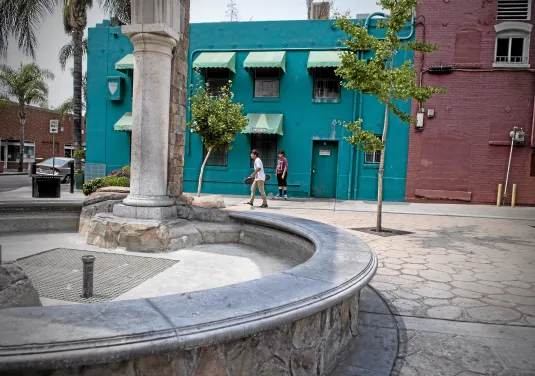In the realm of pipe maintenance, the Alhambra’s Water Softening Guidelines emerge as a pivotal beacon. Recognizing the intrinsic link between water quality and the longevity of piping systems, these guidelines delineate essential measures for mitigating the adverse effects of hard water. The Alhambra’s directives are not merely a set of recommendations; they epitomize a strategic approach to safeguarding pipes from mineral deposits and corrosion. As water hardness poses a substantial threat to infrastructure integrity, adherence to these guidelines becomes paramount in preserving the efficiency and lifespan of pipelines. This introduction The Pro Plumbing underscores the crucial role played by Alhambra’s Water Softening Guidelines in sustaining the health of water conveyance systems.
Preserving Infrastructure Integrity:
Preserving infrastructure integrity stands as a paramount objective within Alhambra’s Water Softening Guidelines. These guidelines meticulously outline a comprehensive approach to shield the intricate network of pipes from the detrimental effects of hard water. By acknowledging the corrosive nature of minerals present in hard water, the guidelines offer strategic measures to counteract potential damage. The emphasis is not solely on reactive measures but on a proactive stance, ensuring that the structural integrity of pipes is upheld over time. Through the implementation of these guidelines, Alhambra prioritizes the long-term resilience of water conveyance systems, recognizing that the preservation of infrastructure integrity is foundational to the sustainable and efficient functioning of these vital networks.
Minimizing Mineral Deposits:
Minimizing mineral deposits is a pivotal facet of Alhambra’s Water Softening Guidelines, underscoring a proactive approach to address the challenges posed by hard water. These guidelines provide a meticulous roadmap for curtailing the accumulation of minerals, particularly scale, within pipelines. Recognizing that the gradual buildup of deposits can impede water flow and compromise the efficiency of the entire system, Alhambra advocates for water softening practices to mitigate these adverse effects. By implementing measures such as ion exchange or other proven softening techniques, the guidelines aim to reduce the risk of mineral deposits, preserving the unobstructed flow of water and ensuring the longevity and optimal performance of the piping infrastructure. In doing so, Alhambra’s approach contributes to not only the functional efficiency of water systems but also to the overall sustainability of water management practices.

Corrosion Prevention:
Corrosion prevention, central to Alhambra’s Water Softening Guidelines, represents a comprehensive strategy for safeguarding piping systems’ longevity. Recognizing the corrosive impact of hard water, Alhambra advocates for protective measures. Emphasizing water softening to reduce mineral content and prevent accelerated corrosion, the guidelines offer a preemptive approach to preserve structural integrity. Beyond extending infrastructure lifespan, Alhambra’s commitment acts as a proactive shield, mitigating environmental and economic implications associated with corrosion. In embracing these guidelines, a resilient defense is established, ensuring sustained functionality and reliability, making it an invaluable resource for both corrosion prevention and pipe fixing services.
Enhancing Longevity:
- Proactive Maintenance: Alhambra’s Water Softening Guidelines advocate for proactive measures to counteract the impact of hard water on pipes, ensuring longevity by preventing issues before they arise.
- Reduced Wear and Tear: By minimizing mineral deposits and corrosion, the guidelines contribute to a reduction in wear and tear on pipes, extending their operational lifespan.
- Minimized Replacement Costs: The emphasis on longevity translates into reduced frequency of pipe replacements, leading to substantial cost savings over the long term for both municipalities and individual consumers.
- Sustainable Infrastructure: Prolonging the lifespan of pipes aligns with sustainability goals, as it minimizes the environmental impact associated with the manufacturing, transportation, and disposal of piping materials.
- Reliability in Water Supply: A system adhering to these guidelines ensures a more reliable water supply, reducing the likelihood of disruptions due to pipe failures and enhancing the overall dependability of water infrastructure.
- Optimized Investments: Municipalities and stakeholders benefit from optimized investments as the guidelines promote cost-effective strategies that prioritize the enduring functionality of existing water conveyance systems.
- Adaptability to Future Needs: Long-lasting pipes, as encouraged by the guidelines, provide a robust foundation for adapting to future changes in water demand and distribution requirements, ensuring resilience in evolving water infrastructure needs.
Efficiency Improvement:
Efficiency improvement lies at the core of Alhambra’s Water Softening Guidelines, delineating a strategic framework to optimize the performance of water conveyance systems. By addressing the challenges posed by hard water, these guidelines mitigate the adverse effects on pipes, promoting smoother water flow and sustained operational efficiency. Through the reduction of mineral deposits, the guidelines contribute to unobstructed pipelines, minimizing friction and pressure losses. Enhanced efficiency is not only vital for maintaining the consistent delivery of water but also translates into energy savings, particularly in systems like water heaters and boilers where softened water facilitates improved heat transfer. Alhambra’s focus on efficiency aligns with a broader commitment to resource conservation, economic prudence, and the seamless provision of water services, making these guidelines a cornerstone for fostering sustainable and effective water infrastructure.

Environmental Impact:
Alhambra’s Water Softening Guidelines transcend practical pipe maintenance, prioritizing an environmentally conscious approach. By advocating practices that diminish mineral deposits and corrosion, the guidelines foster pipe longevity, reducing the need for frequent replacements and lessening the environmental impact of manufacturing and disposing of piping materials. Aligned with sustainability goals, they endorse energy-efficient operations, with softened water enhancing heat transfer. This, in turn, lowers energy consumption, reducing carbon emissions and ecological footprints. Alhambra’s holistic approach not only ensures infrastructure longevity but also promotes environmentally responsible practices, making it an essential guide for mitigating ecological consequences in water conveyance systems, particularly in the realm of professional services preventing p;ipe corrosion.
Economic Considerations:
Alhambra’s Water Softening Guidelines are underpinned by a pragmatic recognition of economic considerations in the realm of water infrastructure. By prioritizing preventative measures to counteract the impacts of hard water, the guidelines help municipalities and consumers alike avoid the financial pitfalls associated with reactive repairs and frequent replacements. The focus on corrosion prevention and mineral deposit mitigation translates into substantial cost savings over the long term, as it minimizes the need for extensive maintenance and replacement expenditures. Additionally, the guidelines foster energy efficiency, further contributing to economic benefits by reducing operational costs in systems reliant on water heating. Alhambra’s approach not only safeguards the structural integrity of pipes but also serves as a fiscally responsible strategy, aligning with the principles of prudent financial management in the realm of water infrastructure, exemplifying how regular inspections can prolong the life of your pipes and contribute to long-term economic efficiency.
Compliance with Standards:
- Regulatory Adherence: Alhambra’s Water Softening Guidelines align with established industry regulations and standards, ensuring that water management practices adhere to stipulated requirements.
- Quality Assurance: Following these guidelines guarantees the delivery of water within accepted quality standards, meeting health and safety regulations for both municipal and residential water supplies.
- Infrastructure Resilience: Compliance with established standards enhances the resilience of water infrastructure, as the guidelines incorporate best practices to withstand varying conditions and challenges.
- Public Health Safeguard: Adhering to standards endorsed by Alhambra ensures that water treatment and conveyance prioritize public health, mitigating risks associated with contaminants and mineral buildup.
- Interoperability: Standard compliance facilitates interoperability with other water systems, promoting a cohesive and uniform approach to water management that benefits both local communities and broader regional networks.
- Legal Compliance: Following Alhambra’s guidelines ensures legal compliance, reducing the risk of penalties or legal issues associated with the violation of water quality and infrastructure standards.
- Industry Reputation: Conforming to recognized standards enhances the reputation of water management entities, fostering trust among stakeholders and the general public regarding the safety and reliability of water supplies.
- Future Adaptability: Standardized practices promoted by Alhambra’s guidelines ensure that water systems remain adaptable to evolving regulations, technological advancements, and emerging challenges in the water industry.

Water Quality Assurance:
Water quality assurance takes center stage in Alhambra’s Water Softening Guidelines, embodying a commitment to ensuring the purity and safety of water supplies. By meticulously addressing the challenges posed by hard water, these guidelines safeguard against the degradation of water quality caused by mineral deposits and corrosion within pipes. Alhambra’s emphasis on water softening practices not only enhances the aesthetic aspects of water, preventing issues like unpleasant tastes and odors associated with hard water, but also prioritizes the elimination of potential health hazards. Through the implementation of these guidelines, water quality becomes a paramount consideration, resonating with the overarching goal of delivering consistently safe, clean, and potable water to communities. Alhambra’s approach reflects a comprehensive strategy that extends beyond infrastructure maintenance to ensure the continuous assurance of high-quality water for both domestic and municipal consumption, incorporating innovative pipe repair techniques for a holistic water management solution.
FAQ’s:
How does the Alhambra water system work?
The Alhambra water system relies on a network of wells, aqueducts, and cisterns to source, transport, and distribute water, showcasing a historic hydraulic engineering marvel that utilizes gravity and intricate architecture.
Where does the water for the Alhambra come from?
The water for the Alhambra primarily comes from the Darro River and is channeled through a complex hydraulic system that includes aqueducts and wells.
What is the importance of water in Alhambra?
Water in Alhambra is crucial for its intricate gardens, intricate fountains, and Islamic architecture, showcasing a harmonious integration of nature and design in this historic palace complex.
Does Alhambra water have minerals?
Yes, Alhambra water may contain minerals, and its mineral content can contribute to the formation of deposits, emphasizing the importance of water management strategies like softening to maintain the infrastructure.
What are the unique features of the Alhambra?
The Alhambra is distinguished by its intricate Islamic architecture, Nasrid Palaces, Generalife Gardens, and the use of calligraphy, tilework, and geometric patterns, making it a UNESCO World Heritage Site and a masterpiece of Moorish art and culture.
CONCLUSION:
In conclusion, the significance of Alhambra’s Water Softening Guidelines in pipe maintenance cannot be overstated. These guidelines, with their proactive strategies for addressing the challenges posed by hard water, not only preserve the integrity of infrastructure but also contribute to the efficiency, longevity, and environmental sustainability of water conveyance systems. By emphasizing compliance with standards, economic prudence, and the assurance of water quality, Alhambra’s approach serves as a holistic blueprint for responsible water management. In essence, these guidelines reflect a timeless commitment to preserving both the historic architectural marvel of Alhambra and the fundamental principles of effective and sustainable water infrastructure management.





